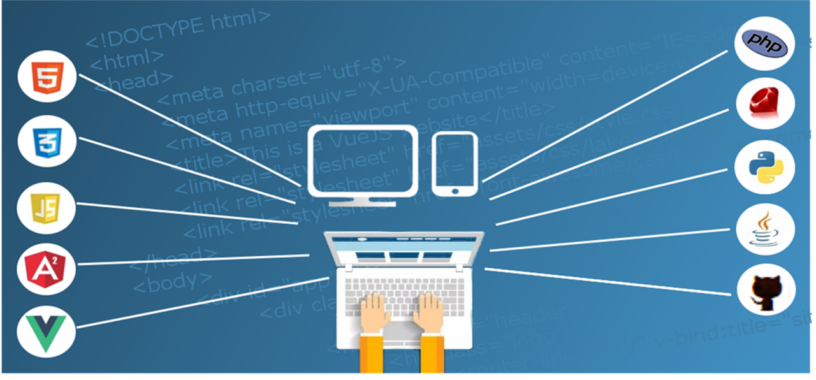The term “full-stack development” has become extremely popular in the constantly changing field of software development. To succeed in this position, what does it mean to be a full-stack developer, and what qualifications are needed? The complexities of full-stack development, a look at the necessary competencies, and some excellent learning resources are covered in this article to assist software engineers in starting their journey to become competent full-stack developers.
Defining Full-Stack Development:
Full-stack development refers to the practice of working on both the front-end and back-end aspects of a web application. A full-stack developer possesses a well-rounded skill set that allows them to handle various aspects of software development, from designing user interfaces to managing databases and server-side logic.
Essential Skills for Full-Stack Developers:
- Front-End Technologies:
- HTML: Understand the structure of web pages.
- CSS: Style web pages and create responsive designs.
- JavaScript: Implement dynamic and interactive elements on the client side.
- Front-End Frameworks:
- React.js: A popular JavaScript library for building user interfaces.
- Angular: A robust front-end framework maintained by Google.
- Vue.js: A progressive framework for building user interfaces.
- Back-End Technologies:
- Server-Side Languages: Learn languages such as Node.js (JavaScript), Python, Ruby, or Java.
- Databases: Gain proficiency in working with databases like MySQL, PostgreSQL, or MongoDB.
- API Development: Understand how to create and consume APIs for data exchange.
- Back-End Frameworks:
- Express.js (Node.js): A minimal and flexible Node.js web application framework.
- Django (Python): A high-level Python web framework.
- Ruby on Rails: A web application framework written in Ruby.
- Version Control:
- Git: Master the basics of version control for collaborative development.
- DevOps and Deployment:
- Familiarize yourself with cloud platforms (AWS, Azure, or Google Cloud).
- Learn containerization with Docker.
- Understand continuous integration and deployment (CI/CD) processes.
Learning Resources for Full-Stack Development:
- Online Courses:
- Coursera: “Full Stack Web Development” by The Hong Kong University of Science and Technology.
- Udacity: “Full Stack Web Developer Nanodegree” program.
- freeCodeCamp: A free, self-paced curriculum covering full-stack development.
- Books:
- “Eloquent JavaScript” by Marijn Haverbeke for mastering JavaScript.
- “Learning React” by Alex Banks and Eve Porcello for React.js.
- “Flask Web Development” by Miguel Grinberg for Python and Flask.
- Coding Platforms:
- LeetCode and HackerRank for honing algorithmic and coding skills.
- GitHub: Contribute to open-source projects to gain practical experience.
- Community and Networking:
- Attend meetups, conferences, and webinars in your local tech community.
- Engage in online forums like Stack Overflow and Reddit to seek advice and share knowledge.
In Summary, Hands-on experience, commitment, and ongoing learning are necessary for becoming a skilled full-stack developer. Achieving success in full-stack development can be facilitated by learning both front-end and back-end technologies, implementing best practices for deployment and version control, and maintaining professional connections with the developer community. The road to full-stack mastery is just as rewarding as the destination itself, so embrace the adventure and learn about new technologies.
Happy Learning !!

Answers to Frequently Asked Questions on Full Stack Development:
1. What is full stack development?
Full stack development refers to the process of building web applications or software by working on both the front-end (client-side) and back-end (server-side) aspects. A full-stack developer has the skills and knowledge to handle the entire development cycle, from user interface design to server logic and database interaction.
2. What are the 3 layers of full stack development?
While there can be more layers depending on complexity, a common way to view it is:
- Presentation Layer (Front-End): This is what users interact with directly. It involves designing and developing the user interface (UI) using HTML, CSS, and JavaScript frameworks like React or Angular.
- Business Logic Layer (Back-End): This layer handles the core functionality of the application. It involves server-side scripting languages like Python, PHP, Node.js, and frameworks that manage data processing, business logic, and communication with the database.
- Data Layer: This layer stores and retrieves data. It involves working with relational databases (like MySQL) or NoSQL databases (like MongoDB) depending on the application’s needs.
3. What is a full stack developer doing?
A full-stack developer can be involved in all stages of the development lifecycle, including:
- Designing and building the user interface (UI).
- Writing code for the front-end and back-end of the application.
- Developing APIs (Application Programming Interfaces) for data exchange between different parts of the application.
- Setting up and managing databases.
- Testing and debugging the application.
4. What are the skills required for a full stack developer?
Full-stack developers need a broad skillset encompassing:
- Front-End Technologies: HTML, CSS, JavaScript, front-end frameworks (React, Angular, Vue.js).
- Back-End Technologies: Server-side scripting languages (Python, PHP, Node.js), back-end frameworks (Django, Ruby on Rails, Express.js).
- Databases: SQL and NoSQL databases.
- Version Control Systems: Git
- Soft Skills: Problem-solving, critical thinking, communication, collaboration.




2 Pingbacks